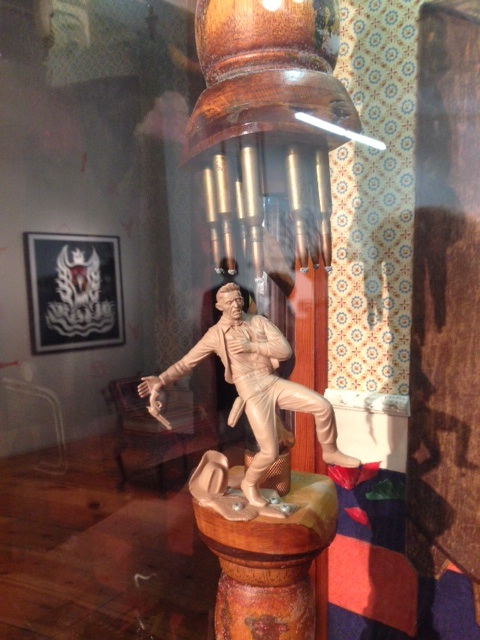Authenticity City
AUTHENTICITY CITY Clayton Patterson and Elsa Rensaa
Outside In
Curated by Ted Riederer
Howl! Happening
June 19 – August 14, 2015
By Jeffrey Cyphers Wright
Pictured: Installation shot featuring Clayton Patterson’s “Blue Boy And Pinky In The House” 1976, Mixed media
Dressed in his signature Goth/punk regalia and sporting gold teeth and a long, gnarly beard, Clayton Patterson has the beaming mien of a gangster wizard — or a super hero of the urban spectacle.
Best known as a contrarian/documentarian for his important Tompkins Square Riot footage, Clayton Patterson is much more than a filmmaker and legendary freedom fighter. As you may know, he is also a designer, historian, publisher, archivist, prolific photographer — and, it turns out, a startlingly original artist. He and his long time companion, fellow collaborator and fine artist Elsa Rensaa, are the subjects of a blowout show at Howl Happening.
Patterson’s photographic documentation (he’s reportedly taken over 100,000 photos) is well known. This show included a sampling of those iconic portraits of exuberant adolescents, tattooed gang members, masked drug dealers and other denizens of the LES.
Patterson’s art speaks to the street. It’s as if he’s stitched parts of downtown New York into quilts. And he and Elsa have literally stitched designs (including his trademark skull) onto clothing and caps, recalling a motorcycle club aesthetic or military souvenir jackets.
Also in this show were a dozen or so impressive sculptures. Recognizing the entropic pressures on society, Patterson redirects the energy he encounters. First, he gathers shards of culture from the streets and then he creates new contexts for his found materials. Old steamer trunks, boxes, balusters and drawers become stages for operatic tableaux. Toy soldiers glow under a black light. Knives provide rhythms to chaotic juxtapositions.
These assemblage pieces combine Joseph Cornell’ fairy tale charm with the anti-sentimentality of Robert Rauschenberg’s “gluts” that “simply wanted to present people with their ruins.”
If Patterson incorporates the ruins, he also revitalizes them, resurrecting detritus and giving it new life. More recent affinities would include the Wunderkammer aspect of Joe Coleman’s freak art/museum collection and the Fusion Art of Shalom.
In one of Patterson’s pieces, a manikin recalls a boardwalk fortune- telling machine. A gypsy spirit pervades. Like magic portals in an arcade, these works suspend belief. They will draw you in to their mysterious overtures. One of them would look terrific in a museum. I could definitely see one holding up next to a sculpture by Louise Nevelson or Marisol.
